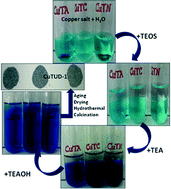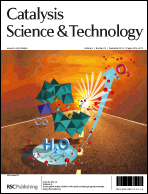The impact of the copper source on the synthesis of meso-structured CuTUD-1: a promising catalyst for phenol hydroxylation†
Abstract
In the direct hydrothermal synthesis of copper containing mesoporous materials, various factors such as the Cu(II) ion distribution, the coordination environment and the quantity of Cu2+ incorporation/grafting etc. influence catalytic activity. For these reasons, the copper source added during the synthesis plays a crucial role. In this work, three different CuTUD-1 materials with similar Si/Cu ratios (100) were synthesized with three different copper precursors (copper acetate (CuTA), copper chloride (CuTC) and copper nitrate (CuTN)). The physico-chemical properties of these CuTUD-1 materials were examined by XRD, N2 sorption studies, ICP-OES, Diffuse Reflectance UV–Vis, FT Raman spectroscopy, TPR and XPS characterization techniques. The results revealed that the distribution of isolated Cu2+ species and oligonuclear CuO nanoclusters varied with different Cu sources. Copper nitrate yielded highly distributed isolated Cu2+ sites, whereas oligonuclear CuO was observed as the major species when copper acetate was used as the Cu source. These materials were tested as catalysts for liquid phase hydroxylation of phenol with H2O2. The significantly higher performance of the CuTN catalyst over that of the CuTC and CuTA catalysts was attributed to the larger amounts of active isolated Cu(II) species connected to the TUD-1 silica lattice. Moreover, the CuTUD-1 materials showed better catalytic activity than other copper based mesoporous systems (MCM-41, MCM-48 and SBA-15).


 Please wait while we load your content...
Please wait while we load your content...